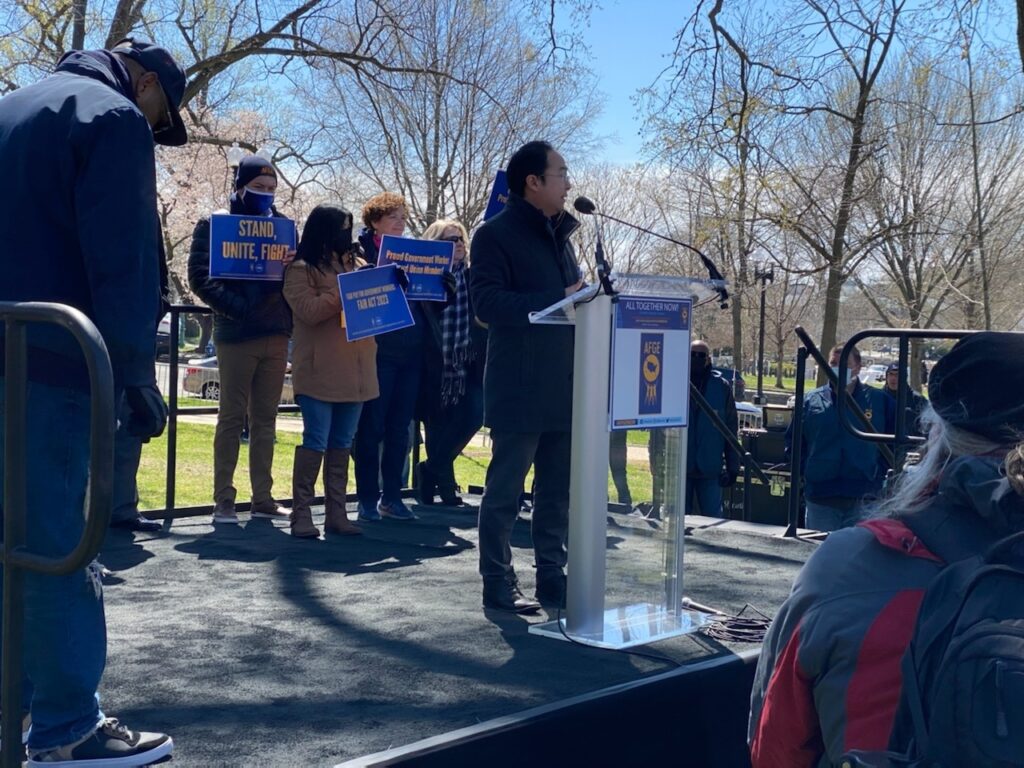Kim Connects with Key Constituency at Capitol Hill Federal Worker Rally

WASHINGTON D.C.- New Jersey Rep. Andy Kim channeled his inner union organizer this week when he took to the stage at the energetic mid-day rally on Capitol Hill for the American Federation of Government Employees, the nation’s largest federal work union. AFGE – which backs Kim’s reelection – represents 700,000 civil servants in all fifty states for just about every agency from the EPA to the Veterans Administration.
Kim, himself a former federal employee, told the crowd of a few hundred “they all deserved better” and that AFGE’s demands for higher wages was completely justified at a time when “families are struggling right now, wondering how they are going to pay the bills.” Kim, who was only elected in 2018 to his 3rd district seat, was a decidedly junior member of the high powered program that included House Majority Leader Stenny Hoyer (D-Md) and Rep. Gerry Connelly (D-Va.)
Kim’s remarks on March 29 came the day after Dr. Everett Kelley, AFGE’s national president confirmed for InsiderNJ that the union lost at least 600 members during COVID, many through their occupational exposure to the deadly virus. Union officials have confirmed that they have anecdotal reports of so-called long COVID symptoms among their members of varying severity that have persisted months after the initial infection.
Early on, the union’s TSA officers were some of the first to be infected and killed by COVID. AFGE members and their families serving in congregant facilities like the ones run by the Veteran’s Administration and the Bureau of Prisons were particularly hard hit as well as those with frontline job titles like USDA inspector in the nation’s meat processing plants were also put at significant risk. Throughout the pandemic, particularly during the Trump administration, federal agencies refused to provide the union with any information about the status of the pandemic within their operations as the death toll mounted.
“What I also believe is that service is an honorable thing, but service isn’t sacrifice,” Kim told the union crowd. “You should not have to sacrifice your life….You are not asking for the moon—you are looking for fairness. You are asking for respect. You are asking for justice in the work you are doing.”
In an interview with InsiderNJ after the rally, Kim said that as a member of Congress from New Jersey, which was one of the state’s where COVID was most devastating, he was concerned that there were still many open questions about the impact of the virus and all of its mutations on all front line workers who can’t work remotely when a surge in infectious disease requires it.
“We definitely need to have more information about this,” he said. “There’s a lot we still don’t know about the total effects of how devastating COVID is as we approach one million lives lost—and that’s just the ones that have been counted, In New Jersey, we got hit early very hard and that was before we were able to have the kind of testing we needed to know who had hit and who didn’t. There’s probably a lot there we don’t understand about what happened generally in New Jersey during the pandemic.
There is no current registry of the number of the nation’s healthcare professionals, first responders, transit workers and other essential workers who died of their occupational exposure to the deadly virus, Similarly, while there have been multiple reports of the transmission of the virus from the essential workforce to their families, those accounts remain anecdotal. The Guardian and Kaiser Health News reported that in the first year of the pandemic, 3,600 American healthcare workers died as a consequence of their occupational exposure.
Rebecca Reindel, the national AFL-CIO’s director of Occupational Safety & Health told InsiderNJ that one of the federal government’s biggest failure during the pandemic “is that it never took the role of the workplace in an infectious disease outbreak seriously and didn’t take action to protect people in these settings where there was a power relation between workers and employers. We also did not create strong laws upfront to protect workers on the job and we never did proper surveillance to count who was getting sick and in what industries they were working in.”
According to Reindel, earlier this year, the nation’s labor unions won a major victory when Congress approved budget language requiring the CDC to conduct the first “comprehensive national study on COVID deaths and COVID infections by occupation and industry. “CDC has to produce this report to Congress within six months and it will show how may workers were effected by COVID and where the high risk settings are,” Reindel said. So far, only Massachusetts and California have done such a study.
The AFGE Capitol Hill rally comes after several very difficult years for the federal union workforce which was targeted by in May of 2018 President Trump with several executive orders that sought to eliminate the presence and role of the unions in the federal workforce. During Trump’s tumultuous tenure, his administration targeted for downsizing and closure offices that were part of the scientific expertise staffs that helped agencies like the USDA and EPA monitor corporate compliance with federal law.
From December 22, 2018 through January 25, 2019, Trump presided over a 35 day shutdown of the federal government, the longest in history. However, hundreds of thousands of essential workers in frontline agencies like the Veterans Administration, the Transportation Safety Administration and the Bureau of Prisons had to continue to work without getting paid. Across the country, local news outlets reported that thousands of these federal civil servants had to resort to local food banks and pantries. Ultimately, once the government shutdown ended, Congress approved legislation to retroactively compensate those workers as well as those who were furloughed.
In August of 2018, in her now famous ‘Presidents are not Kings’ ruling, then U.S. District Court Judge Ketanji Jackson, ruled that Trump’s anti-union executive orders violated the 1st Amendment of the U.S. Constitution and the separation of powers among the three branches of the Federal government. In her 119-page opinion, President Biden’s Supreme Court nominee conceded that while it was well within Trump’s purview to issue Executive Orders on labor relations, those directives could not undermine existing and well established collective bargaining rights. “And because many of the executive order provisions that the unions challenge have that effect, this court concludes that the President has overstepped his bounds,” Jackson wrote.
Even before Trump was elected in 2016, were under attack by powerful figures within the Republican Congressional caucus who were fervently committed to privatizing federal government functions while radically reducing the size of the federal workforce.
As a consequence, since 2011 a combination of pay freezes and benefit rollbacks has meant that federal workers “forfeited $246 billion”, according to AFGE. And like the rest of the American workforce, federal workers wages, when accounting for inflation, are 9.2 percent lower than they were a decade ago by the union’s calculations. According to the independent Federal Salary Council, federal worker salaries are 23 percent lower that what’s paid to workers performing similar functions in the private sector. That disparity is particularly pronounced in the Department of Homeland Security’s Transportation Safety Administration’s airport screeners’ title where pay can be as low as $30,000 per year.
President Biden’s latest budget proposal calls for an average 30 percent pay boost for this workforce, as well as a 20 percent increase in the base pay for the nation’s federal air marshals. Throughout the pandemic, the FAA has documented a dramatic surge in violent attacks by air travelers, including in-flight disruptions involving the enforcement of masking requirements.
The federal workforce is a key constituency for Kim and his Democratic colleagues in the House, who are widely expected to lose their single digit control of that body in the upcoming elections in November.
In 2016, Trump carried New Jersey’s 3rd by a 51 percent to 45 percent margin over former Secretary of State Hillary Clinton. The district, which includes most of Burlington County and parts of Ocean County, voted for President Obama in 2008 and 2012. In 2018. Kim, as a newcomer, defeated the Republican incumbent Rep. Tom MacArthur by just under 4,000 votes. In that non-presidential election year, 300,000 voters turned out for that contest. His win was determinative as to which party controlled Congress.
In 2020, with President Biden at the top of the ticket, Kim improved on his performance winning over 53 percent of the votes cast when the turnout spiked to more than 426,000 voters. While there are roughly just 25,000 non-postal federal civil servants working in New Jersey, the national government employs close to 105,000 people in Pennsylvania and New York who might live in New Jersey and are usually engaged voters known to turn out even in non-presidential federal elections.
Historically, the nation’s federal civil servants and their unions have been heavily courted by both Republican and Democratic Congressional campaigns, particularly in rural states and swing districts, where their votes can determine the outcome of a race.
A case in point would be the late Rep. Don Young (R-Alaska) who died earlier this month. The 88-year-old Congressman, the longest serving Republican, was first elected in 1973 and throughout his career was one of the AFGE’s most ardent supporters. At the start of the AFGE Capitol Hill rally, Kelley, AFGE’s president asked the lunchtime rally crowd for a moment of silence to honor Young who died March 18.









Leave a Reply